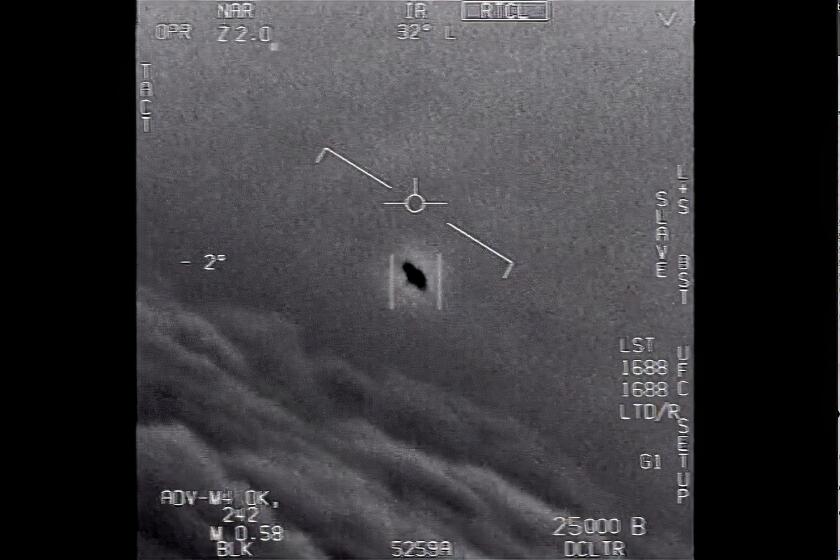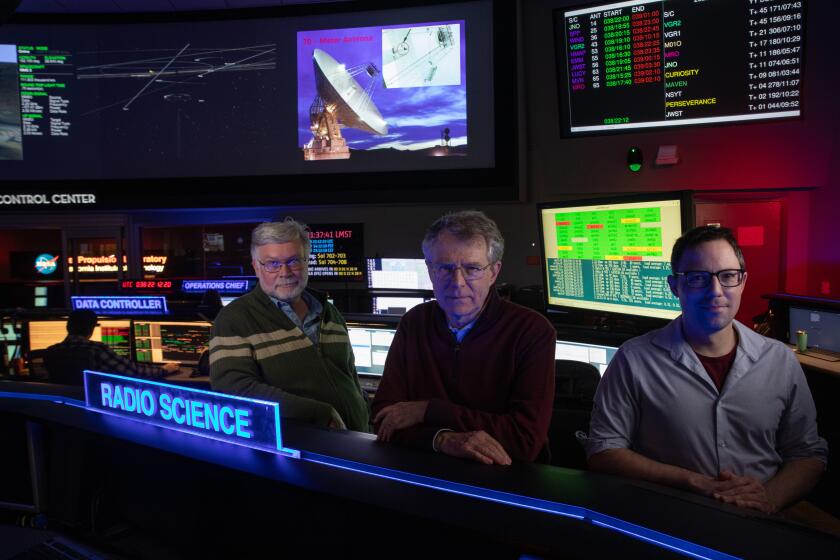Mysterious flying objects are turning up daily. Why experts donât think aliens sent them

The U.S. government has shot down multiple unidentified flying objects out of North American airspace in recent days. This is not a drill.
The things downed over Alaska, Michigan and Canadaâs Yukon Territory are textbook UFOs. Theyâre objects, theyâre flying and theyâre most definitely unidentified â so far, no one has been able to conclusively discern what they are or rule out any explanation for their presence.
That includes the possibility that theyâre not from this world.
âI havenât ruled out anything,â Gen. Glen VanHerck, the head of NORAD and U.S. Northern Command, said when asked specifically about the possibility that the objects are extraterrestrial in origin. âAt this point we continue to assess every threat or potential threat, unknown, that approaches North America with an attempt to identify it.â
VanHerck may be keeping an open mind, but those most familiar with the reaches of outer space are more certain that these objects did not come from there.
Yes, the universe is a rich tapestry of mysteries. But it also abides by some fundamental laws of physics that make it extremely difficult for any object to travel across interstellar space and into our lower atmosphere undetected.
âUnidentifiedâ doesnât mean âitâs aliensâ â it simply means that no one yet knows what it is. The number of unusual sightings that fit this criteria has increased in recent years, to the point where both the U.S. Department of Defense and NASA have embraced and legitimized the study of UFOs. They even gave the objects a new, more scientific-sounding name: unidentified anomalous phenomena, or UAPs.
Biden administration officials are racing to provide more details on the origins of multiple objects shot down by U.S. military over the weekend.
U.S. military personnel have reported dozens of sightings of aerial objects that defy explanation, according to a report made public in 2021. Last year, NASA launched a study to determine which of its vast resources should be deployed toward further exploration of UAPs.
The goal is to remove the stigma of reporting a UAP sighting so that legitimate threats can be investigated. The Pentagon is at least as worried about the possibility of a new aerial weapon deployed by a foreign adversary as it is about aliens.
As for scientists, even those who accept the possibility that life may exist elsewhere in the universe are highly skeptical that the enigmatic objects are extraterrestrial. The bar for proving alien life is high, and these flying things â whatever they are â donât clear it.
âIf youâre claiming aliens came, thatâs kind of a big olâ hairy deal. Weâve never seen anything like that. That should never be the first place your brain goes,â said Bruce Betts, chief scientist for the Planetary Society. âOdds are thatâs not the answer.â
Here are a few of the reasons why aliens arenât likely to be the source of these unidentified objects.
Distance
Even astronomers who specialize in the search for extraterrestrial intelligence dismissed the possibility that these UAPs were sent by aliens.
âThe impracticalities of interstellar travel are substantial,â said Jean-Luc Margot, a planetary astronomer who leads UCLAâs SETI (Search for Extraterrestrial Intelligence) Group.
Despite extensive efforts, the only life scientists have been able to identify in this solar system is right here on our planet. After our sun, the next closest star is Proxima Centauri, which is 4.3 light-years â 25.3 trillion miles â away.
Letâs use Proxima Centauri as an example. Any object dispatched from its surrounding exoplanets would have to cross that staggering distance to get to us.
An object traveling 365,000 mph â just under the top speed of NASAâs Parker Solar Probe, currently the fastest human-made object in the universe â would take 7,912 years to get from Proxima Centauri to us. If it could somehow travel at the speed of light â which would require so much energy that the slightest ding from an errant space rock would cause the craft to explode â it would still take more than four years to get here.
NASA is embarking on a new study on unidentified aerial phenomena, or UAPs â the term scientists use instead of UFOs.
More significantly, any signals sent between the spacecraft and a base on its home planet would take those four-plus years to travel. That communication delay would complicate a mission involving an unmanned â unaliened? â robotic craft, Betts said.
A crewed mission would be even tougher.
âWhen you have size and mass and life support, spacecraft get big in a real hurry. That makes it even harder to make them go fast,â Betts said.
This is just our closest star. There are 100 billion stars in our galaxy alone. The rest are even farther away.
Observation
Letâs say our hypothetical alien spacecraft somehow manages to cross some significant part of the Milky Way and make it to our solar system. The closer the craft gets to Earth, the harder it will be for it to evade detection by the multitude of tools observing the cosmos around us.
The Solar Systems Dynamics Group at NASAâs Jet Propulsion Laboratory alone is currently tracking the orbits of some 1.2 million small objects in Earthâs immediate vicinity. Telescopes on the ground can spot objects the size of a duffel bag from tens of thousands of miles away, often years in advance of any approach to Earth.
When one of the smaller of these objects crashed through Earthâs atmosphere on Monday â a 1-meter-wide asteroid named Sar2667 â the European Space Agency and NASAâs Center for Near-Earth Object Studies knew well in advance how big it was, where it would enter the atmosphere (over northern France) and what time it would get there (around 4 a.m. Central European Time).
If these downed objects came from space, how did they manage to slip past all observation systems?
U.S. and Canadian authorities had restricted some airspace over Lake Huron as planes were scrambled to intercept and try to identify the object.
Besides, thereâs a more plausible explanation for the sudden increase in UAP detection. After the discovery of a Chinese surveillance balloon in U.S. airspace last week, the Pentagon has stepped up its scrutiny of objects in the sky. Things that would have been ignored in the past are now getting a closer look. That includes slower-moving objects that were detected after the U.S. adjusted its radar systems.
âWeâve been able to get a better categorization of radar tracks now,â VanHerck said. âThatâs why I think youâre seeing these, plus thereâs a heightened alert to look for this information.â
Practical problems
Then there are a whole host of other questions.
Sar2667 had been speeding through the vacuum of space when it encountered the atmosphere, and the resulting friction caused it to burn up over the English Channel. If these UAPs came from outer space, how would they have survived the fiery entry into our atmosphere without similar destruction?
What kind of alien technology could survive a trip across space and safely enter the atmosphere, only to get downed by a missile above Lake Huron or Deadhorse, Alaska?
If there is an intelligent civilization out there, why would these easily destructible things be the way they signal their presence?
A huge asteroid will fly by Earth in April 2029. It wonât be close enough to hit us, but it will be close enough to study, so scientists are getting ready.
Medical students are told to picture horses and not zebras when they hear the sound of hoofbeats â a metaphor that cautions aspiring doctors not to be so distracted by the prospect of an exotic diagnosis that they overlook common explanations for a patientâs symptoms.
The study of UAPs follows similar principles.
Betts invoked the phrase Carl Sagan popularized in regard to the search for extraterrestrial life: Extraordinary claims require extraordinary evidence. What weâve seen so far from the UAPs above North America doesnât come close, he said.
âThereâs no reason to believe that it is from somewhere else. There are a range of explanations that are much easier to stomach,â he said. âWe have no solid evidence of aliens ever coming to our planet.â











